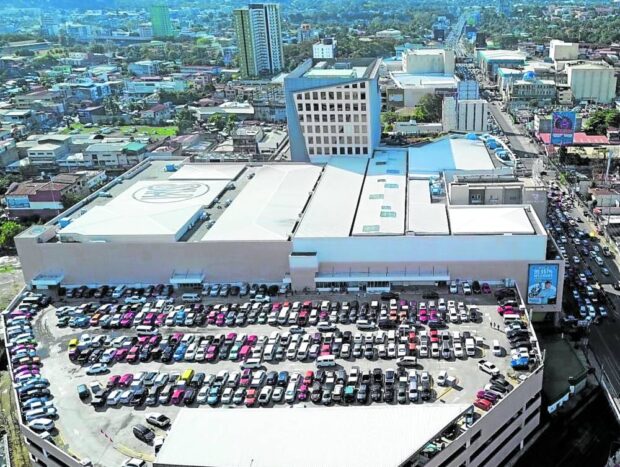Northern Mindanao workers get P33 wage hike

BRISK BUSINESS Vehicles almost fill the parking space of a shopping mall in Cagayan de Oro City during the recent holiday, indicating the return of business vibrancy in Northern Mindanao’s regional capital. —PHOTO COURTESY OF NORTHERN MINDANAO ETC
CAGAYAN DE ORO CITY — While they defer to the wisdom of Congress regarding a legislated general wage hike throughout the country, members of Northern Mindanao’s wage-fixing body said such a measure should not be a disincentive to business growth.
Milbert Macarambon of the All Workers Alliance Trade Union-Trade Union Congress of the Philippines (AWATU-TUCP) told reporters here on Thursday that the recent P33 increase in the region’s minimum wage considered both the need to raise the earnings of workers as well as the capacity of employers to absorb additional labor costs.
READ: ‘Kasambahay’ in NCR to get P500 monthly wage hike starting 2024
Through Wage Order No. RX-22, the Regional Tripartite Wages and Productivity Board (RTWPB) mandated a wage hike of P23 starting Jan. 11, and another P10 on July 1.If fully implemented by July 1, workers in the agriculture sector in major localities will earn P426 a day, and P411 in other areas. Those in the nonagriculture sector in major localities will get P438 a day, and P423 in other areas.
Macarambon, who sits as labor representative in the RTWPB, said their deliberation for a new minimum wage was done in the context of a proposal in Congress, mainly advocated by Senate President Juan Miguel Zubiri, for a P150 across the board daily wage hike.
Reality
“On the part of the labor sector, such a proposal is highly welcome, and I am one of those who supported it. But there are other realities that come into play when we, in the RTWPB, consider what would be a viable rate of wage increase,” Macarambon said.
Article continues after this advertisementLimuel Oliverio of the Mindanao Alliance of Land Transport Unions, who also sits as labor representative in the RTWPB, said the fixing of minimum wage in the region had to contend with the prevalence of micro and small enterprises.
Article continues after this advertisementREAD: Workers in 3 regions to get P30 daily wage hike
According to the Department of Labor and Employment (Dole), about 90 percent of Northern Mindanao’s 40,252 business establishments registered in 2022 belonged to the micro and small categories.
“We were sensitive to this reality when considering the wage rate increase. We also looked into allowing the further growth of businesses so that more people will be employed,” Oliverio said.
A minimum wage order, he said, may not matter so much for organized labor in medium and large business establishments as they have the collective bargaining power.
Assessment
The deliberation for a new wage order did not stem from a petition, usually from the labor sector, but rather from the RTWPB’s own assessment of the region’s socioeconomic landscape.
“The review of our socioeconomic condition shows there is a need to adjust wages,” said Arsenio Sebastian, who represents the management sector in the RTWPB.
He noted that three of four wage rates in the previous wage order already fell below the poverty threshold, using the result of the 2021 Family Income and Expenditure Survey of the Philippine Statistics Authority.
In Northern Mindanao, a family has to earn P400 a day to be above the poverty threshold.
Sebastian added that the wage increase “was also balanced with the goal of attracting investments into the region to generate more jobs.”
He said they specifically considered the region’s competitiveness as an investment destination vis-a-vis Cebu and Davao.
During the wage consultations, Macarambon noted that business leaders in Misamis Occidental province begged off when asked to offer an amount for a wage hike while those in Cagayan de Oro City, the regional capital, offered P25.
AWATU-TUCP’s proposal was P50, he added.
Consensus
The RTWPB deliberation, according to Macarambon, was aided by simulations prepared by the National Economic and Development Authority which earlier noted a dramatic turnaround of the regional economy in 2022.
Dole regional director Erwin Aquino, who chairs the RTWPB, said the new wage order reflected the consensus of labor, management and government which were all represented in the body.
There is a 90-percent compliance with minimum wage orders among business establishments in Northern Mindanao, Aquino said. Of the more than 1,000 establishments inspected by Dole personnel in 2022, at least 700 were found to have followed the wage order, he added.
The 300 who were remiss eventually complied upon receipt of compliance order from the RTWPB.
Aquino called on minimum wage earners to report to Dole their employers who refuse to abide by the new wage order.